what to expect when rotator cuff tear has to be attached to another tendon
Virtually people feel some shoulder pain from fourth dimension to fourth dimension, whether from repetitive motion, overextension or another injury source. When the pain doesn't go away, however, it can cause significant issues in everyday life. Identifying the source of the problem is the get-go footstep to treatment.
In that location are multiple potential sources of shoulder pain. One possible trouble area is the rotator cuff, which can tear or suffer from a condition chosen tendonitis. Understanding these 2 weather tin can help you have a productive conversation with your physician about your treatment options.
What Is the Rotator Cuff, and Why Is It Of import?
The rotator cuff is a circuitous of four muscles that encompass the top of the upper arm os. The 4 muscles come together in the shoulder as tendons, and the covering they create is thick. The muscles begin at the shoulder bract and stretch to the humerus — the upper arm bone. The rotator cuff consists of these four muscles.
- Supraspinatus: This muscle begins over the spine of the shoulder blade and terminates well-nigh the rounded height of the humerus os, known as the greater tuberosity.
- Infraspinatus: This musculus begins underneath the spine of the shoulder blade and connects to the dorsum of the humerus.
- Teres pocket-size: This musculus begins on the outer side border of the shoulder blade and connects to the smaller side of the humerus' rounded top, known as the lesser tuberosity.
- Subscapularis: This musculus begins on the front of the shoulder blade, which sits directly above the ribs. Information technology too connects to the lesser tuberosity.
With so many points of connexion, the rotator cuff is a sensitive muscle group that tin experience injury for many reasons.
Rotator Cuff Function
The muscles in the rotator cuff work together to facilitate crucial functions of the shoulder. Here are the duties performed and the muscles that work to make them happen.
- Stabilizing the meridian of the humerus in the shoulder: Facilitated by all 4 muscles.
- Lifting the shoulder up and sideways: Facilitated by the supraspinatus.
- Rotating the shoulder externally: Facilitated by the infraspinatus and teres minor.
- Allowing free movement of the humerus during elevation: Facilitated by the subscapularis.
Without all iv rotator cuff muscles working in concert, the humerus bone would non be able to achieve stable movement within the shoulder articulation.
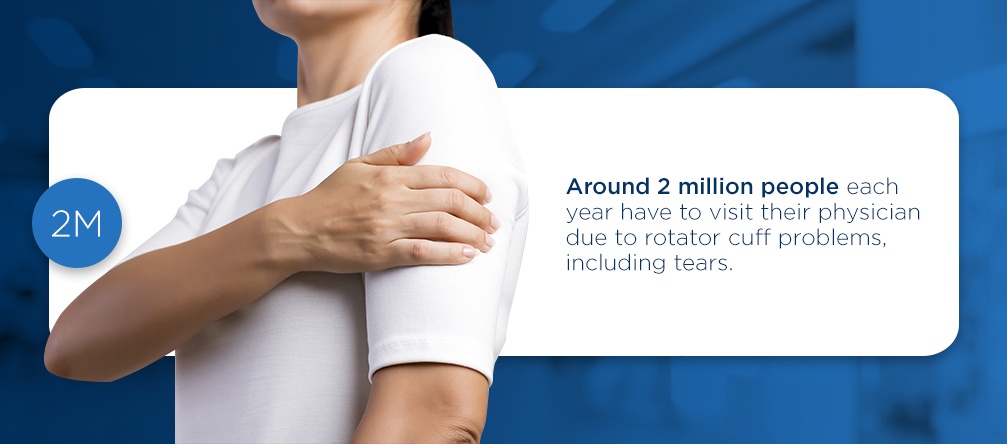
What Is a Rotator Cuff Tear?
Rotator cuff tears are prevalent among adults, causing significant pain and potential disability. Around two 1000000 people each twelvemonth take to visit their doctor due to rotator gage bug, including tears.
When a rotator cuff tears, the shoulder becomes destabilized and weak. This status makes information technology difficult to do a wide variety of everyday activities, such as brushing your hair or even getting dressed.
During a rotator cuff tear event, the tendon's attachment to the head of the humerus rips or possibly even severs. The majority of rotator gage tears occur affect the supraspinatus, but one or more than other tendons tin experience problems besides.
While one isolated incident can tear a rotator gage, many cases begin with the fibers of tendons fraying. If the individual continues to employ the shoulder despite mounting pain, the tendon may tear. This injury often occurs when performing a strenuous action similar lifting a heavy box or another object. There are ii types of rotator cuff tears.
- Partial tear: Also known every bit an incomplete tear, this type causes damage to the tendon, though it does not create consummate severance.
- Total-thickness tear: As well called a complete tear, this type completely separates the tendon from the bone.
Naturally, a total-thickness tear is more than likely to require surgical intervention than a partial tear.
What Causes Rotator Cuff Tears?
Two central occurrences can cause a rotator cuff tear: injuries and degeneration. Either can produce tears of varying severity.
Acute Tears
Experiencing an impact to the arm or shoulder while outstretched can easily effect in a tear. This blazon of injury commonly happens with athletes. Those who don't participate in sports typically feel tears after lifting heavy objects with jerking motions or falling on an outstretched arm.
Degenerative Tear
Like other parts of the body, the tendons in the rotator cuff deteriorate over time. This phenomenon is a natural outcome of aging, and it increases the likelihood of developing a tear over time. Multiple variables factor into developing a degenerative rotator cuff tear.
- Repetitive movements:When someone moves their shoulder in the same patterns over and over again, the strain tin can contribute to a tear. Repetitive motions can occur in sports, certain types of work and even household chores.
- Inadequate blood supply:Aging lessens the blood supply available to the rotator cuff. An insufficient claret supply impairs the body's ability to heal damage to the tendons, and makes it easier to sustain a tear.
- Os spurs: Bone spurs are some other element of aging that influences rotator cuff tears. If they develop on the underside of the acromion — a os fastened to the scapula — spurs may rub on the tendons of the rotator cuff, causing a condition called shoulder impingement.
Information technology is quite common for someone with a degenerative tear to worsen the condition with an astute injury. This compounded issue makes recovery more difficult, but information technology is still treatable.
What Is Rotator Cuff Tendonitis?
Rotator cuff tendonitis, also spelled tendinitis, is the term for irritation or inflammation of the rotator cuff muscles. The inflammation can range from moderate to severe. In cases of acute inflammation, a rotator cuff tendon can become trapped under the acromion, leading to severe chronic hurting.
What causes rotator cuff tendonitis? The condition develops over fourth dimension and can be a result of multiple activities, from sleeping on your shoulder to playing sports that crave significant overhead reaching. Other names for shoulder tendonitis include:
- Tennis shoulder
- Bullpen's shoulder
- Swimmer's shoulder
In some cases, there is no credible crusade for rotator cuff tendonitis. Regardless of the source, shoulder tendonitis is usually treatable with advisable intervention.
How to Diagnose Rotator Cuff Tear or Tendonitis
When y'all come across a md for shoulder pain and suspect a rotator cuff tear or tendonitis, your doctor will start by examining the shoulder in question. The doctor will determine where you feel pain or tenderness, and evaluate the shoulder's range of motion past having yous move the arm in a multifariousness of directions. Additionally, they may guild exams, including the post-obit, as part of a rotator cuff tendonitis test.
- Ten-rays: These images tin determine if you accept a bone spur causing tendonitis.
- Magnetic resonance imaging: An MRI can reveal inflammation and signs of trigger-happy.
- Ultrasonography: An ultrasound is another way to check for inflammation or tearing.
Many people experiencing shoulder hurting practise not know how to differentiate rotator gage tear vs. tendonitis. What does a rotator cuff tear feel like? The nigh common symptoms of a rotator gage tear include the post-obit.
- Hurting when not using the shoulder
- Pain when going to slumber, especially if lying on the affected shoulder
- A crackling or popping feeling upon moving the shoulder in specific ways
- Feeling weakness when trying to elevator objects or rotate the arm
When an astute tear occurs, it generally results in severe hurting. There may be an audible snap, followed by immediate loss of strength in the shoulder and upper arm.
In the case of a degenerative tear, weakness and pain are besides present, but are typically less intense and have a slow onset. Information technology is mutual for the pain to exist quite mild and only appear when you apply the arm and shoulder. Many people observe over-the-counter medications tin can ease the pain at the onset of the condition.
With an untreated tear, the pain will continue to advance to the bespeak where medication does not provide relief. 24-hour interval-to-day tasks will go more than difficult and painful over time.
Tendonitis Symptoms
When determining if you take a rotator cuff tear vs. tendonitis, your doctor volition likely focus on hurting level and functionality. The symptoms of tendonitis are typically mild to brainstorm with and include:
- Audible clicking when using the shoulder
- Hurting upon reaching or lifting
- Hurting, swelling or tenderness present in the front side of the shoulder
- Pain when the shoulder is nevertheless
- Stiffness
As shoulder tendonitis progresses, other issues arise, including:
- Difficulty reaching around the back
- Reduced range of motion and strength in the shoulder
- Pain at night that wakes you up or forces y'all to change position
Rotator cuff tendonitis typically takes a while to develop, but information technology tin can occur suddenly as the result of an injury. In these cases, information technology can closely mimic the symptoms of a rotator cuff tear, making it essential to go a prompt diagnosis from a physician to avoid farther damage.
Handling Options for Rotator Cuff Tears and Tendonitis
If you are experiencing pain in your shoulder, continuing to use it can worsen your condition, whether it is rotator cuff tendonitis vs. violent. Tears can go larger and more difficult to repair over fourth dimension, so it is crucial to get rotator cuff injury treatment equally chop-chop as possible.
Regardless of which status you have, the goal of treatment will exist to reduce the pain yous feel and restore as much part to the rotator cuff as possible. When your doctor is deciding how to care for rotator cuff tendonitis or tears, they will take into account several factors, including:
- Blazon and severity of the injury
- Historic period
- Full general wellness
- Activity level
Surgeries performed on rotator cuff tears are similarly effective, whether performed immediately after an injury or at a later time. That makes nonsurgical treatment the preferable first option in many cases.
Nonsurgical Treatment
The majority of tears and tendonitis cases can do good significantly from nonsurgical handling. The following options tin reduce pain and increment function for most patients.
- Rest: Every bit prolonged use of an injured shoulder can worsen the condition, doctors typically recommend resting the shoulder and avoiding activities that cause pain.
- Nonsteroidal anti-inflammatory medications (NSAIDs): Over-the-counter medications such every bit ibuprofen can reduce swelling and pain.
- Strengthening exercises: Your dr. will give you a listing of exercises or refer you to a physical therapist. The goal of the exercises is to improve mobility, flexibility and force. Strengthening muscles effectually the rotator gage can reduce the adventure of farther injury and reduce pain.
- Steroid injection: In cases where rest, NSAIDs and exercises are not enough to save pain in the shoulder, your medico may apply local anesthetic and cortisone. Although cortisone can exist highly effective at reducing inflammation, it does not work well for anybody.
The main reward of choosing a nonsurgical route is avoiding the risks associated with surgery, such as infection or complications with anesthesia. Surgery besides has a lengthy recovery time. However, nonsurgical approaches are not effective for everyone.
Doctors typically don't treat tendonitis with surgery unless information technology is to remove spurs on the acromion. Rotator cuff tears, on the other mitt, may need surgery to heal properly.
Surgical Treatment
When nonsurgical methods do not produce the desired results for a rotator cuff tear, your physician may shift the focus to surgical options. Consequent, continued pain is the primary indicator that surgery is necessary. Some of the other criteria for surgical intervention include:
- Symptoms persisting longer than six months
- A big tear with practiced quality of surrounding tissue
- Significant loss of office in the shoulder
- Marked weakness in the shoulder
- A tear acquired by an acute injury
Surgery for a rotator cuff tear usually involves repairing the connection between the tendon and the humerus. An orthopedic surgeon can take multiple approaches, and the surgeon volition become over the pros and cons of each technique according to your unique condition.
Recovery From Rotator Cuff Tear and Tendonitis
Rotator cuff tear recovery time is typically four to vi months. For many patients, this time frame is long enough to restore shoulder mobility to normal levels.
Recovery time tin vary if there are complications during or subsequently the surgery. Some postal service-surgical complications that can lengthen rotator cuff recovery fourth dimension include:
- The deltoid muscle detaching at the shoulder, impairing flexibility
- Surrounding nerves becoming injured
- Shoulder remaining stiff and painful when moved
- Infection of the surgical site
In the start week or two after surgery, treatment focus is on keeping swelling and inflammation down so the surgical site can begin to heal. Once the repaired connections between tendon and humerus are stable, the patient can brainstorm rotator cuff tear exercises to amend strength and mobility.
Tendonitis Recovery
How long does rotator cuff tendonitis take to heal? Information technology often depends on the blazon of intervention you receive. Some people successfully recover with balance and activity limitations alone. If you require farther treatment, such equally concrete therapy or cortisone injections, the respond to the question, "How long does rotator cuff tendonitis concluding?" becomes more complicated.
Recovery from rotator cuff tendonitis typically focuses on inflammation and hurting direction. When y'all showtime to feel symptoms of tendonitis, try placing an ice pack against the affected shoulder every iv to 6 hours in increments of xv to twenty minutes. If pain persists, take an NSAID. In combination with recommended exercises, this may be enough to facilitate recovery in a few weeks.
While healing from rotator cuff tendonitis, it'due south essential to avoid lifting anything or using the afflicted shoulder to reach up, out or overhead whenever possible. The exercises your doctor or physical therapist recommends will ideally be the virtually motion the shoulder experiences during recovery.
Rotator Cuff Tendonitis Exercises for Recovery
With both rotator cuff tears and tendonitis, physical therapy is normally the starting betoken unless the injury is very severe. Whether your doctor refers you to a physical therapist or gives you a listing of exercises to perform, the first thing to exercise is determine your current range of motion, so you know what your limits are. The medical professional may recommend a variety of exercises, which can include the post-obit.
1. Pendulum Swing
To do this exercise, you will need a railing, sturdy chair or table. Put your uninjured shoulder's hand on the object to ameliorate stability every bit y'all complete the activity.
- Lean forward slowly while keeping your dorsum flat, and allow your injured arm hang freely.
- Gently swing the arm forward and backward.
- Gently motility the arm side to side.
- Motion the arm in small-scale circles, switching from clockwise to counterclockwise several times.
two. Crossover Arm Stretch
To brainstorm this exercise, stand upwards with your back straight and relax your shoulders as much every bit possible.
- Accomplish the affected arm up to shoulder height and bring it beyond your chest.
- Use the unaffected arm to agree your affected arm'south elbow.
- Repeat the do with the unaffected arm.
Annotation that this exercise should not result in pain, but rather in a stretching sensation. If you are experiencing pain, enquire your dr. or physical therapist how to modify the exercise.
3. Standing Row
For this exercise, you will need a stretch band tied to create a ring around iii anxiety long.
- Affix one end of the loop to a sturdy item and face the object.
- Grasp the other end of the loop and stand far plenty away that the band has no slack.
- Pull on the ring then that your arm forms a ninety-degree bending with the elbow shut to your body.
4. Internal Rotation
This exercise likewise involves the use of a three-pes looped stretch band. It follows the same steps, but rather than performing a pulling-back motion, you move your arm side to side, bringing the forearm over your midsection.
5. Posterior Stretch
You'll perform this standing do with no equipment.
- Agree the elbow region of your injured arm with the hand of your uninjured arm.
- Bring the hand of the injured arm beyond your torso and rest information technology on the reverse shoulder.
- Button the afflicted arm up over your body with your uninjured hand, creating a stretching motility.
Finding the Correct Residual
These and other tendonitis and rotator cuff exercises are elementary enough to comprise into each day, whether yous end upward receiving surgical intervention or stick solely with nonsurgical options. They tin can reduce rotator cuff tendonitis recovery time, but only if you practise them correctly. Yous should not attempt to perform them without consulting a doctor or physical therapist first.
Performing physical therapy exercises without knowing the proper technique or the appropriate number of repetitions tin end up causing more strain rather than helping. If you experience hurting while performing a item action, it's a sign that you need to adjust one or more elements of the do, or try a different one. Either way, it's imperative to consult a health care professional before standing.
Piece of work With OrthoBethesda for Shoulder Injury
Whether you have a tear or tendonitis, you should not take rotator cuff injury treatment lightly. Appropriate handling can preserve the part of the rotator cuff and ameliorate your quality of life, only only if yous select the correct provider.
At OrthoBethesda, we have assembled a team of highly qualified and dedicated orthopedic surgeons, focused on providing each patient with the highest quality of care. Our squad understands that each patient has unique needs, and we strive to take all factors into account when designing handling plans for rotator cuff injuries.
Our doctors take a conservative treatment approach to avert unnecessary surgeries and use cutting-edge technologies in cases where surgical intervention is the all-time option. To learn more and see what OrthoBethesda can do for you, schedule an engagement online, or call (301) 530-1010.
Source: https://www.orthobethesda.com/blog/the-difference-between-rotator-cuff-tears-and-shoulder-tendonitis/
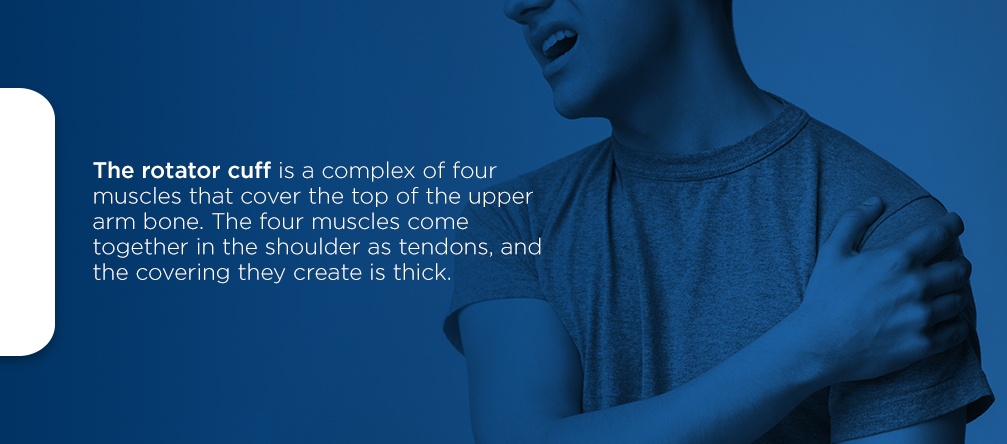
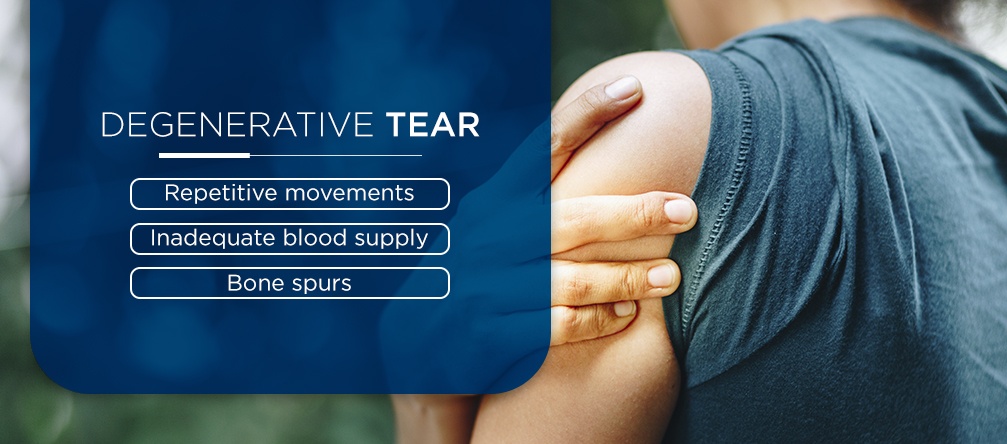
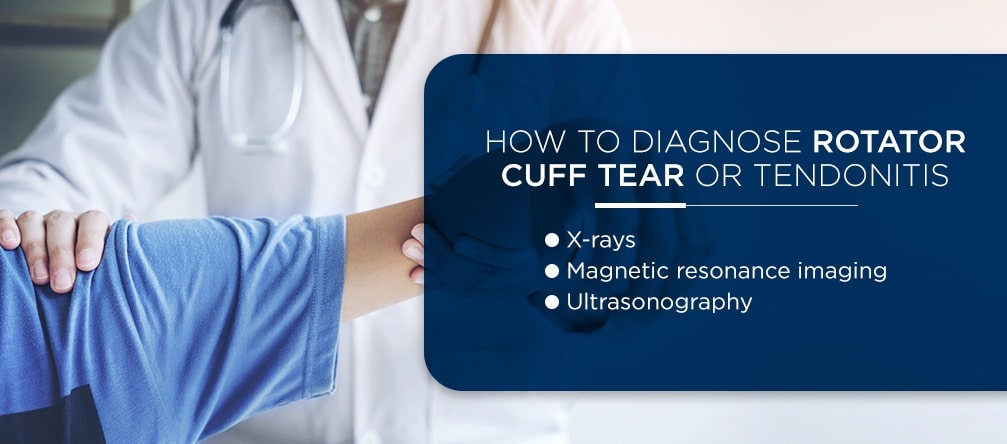
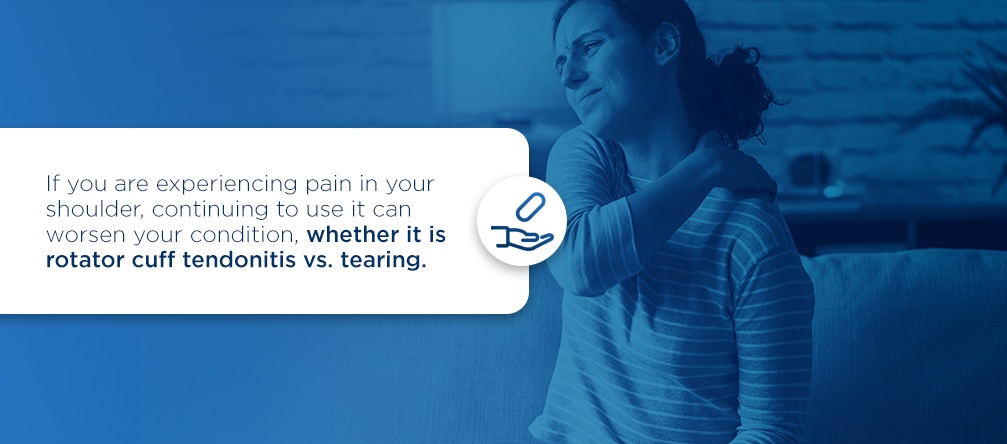
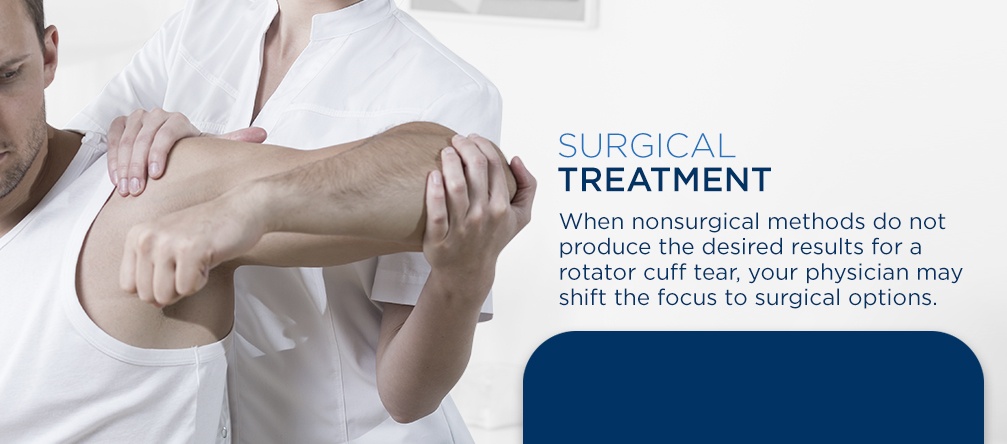
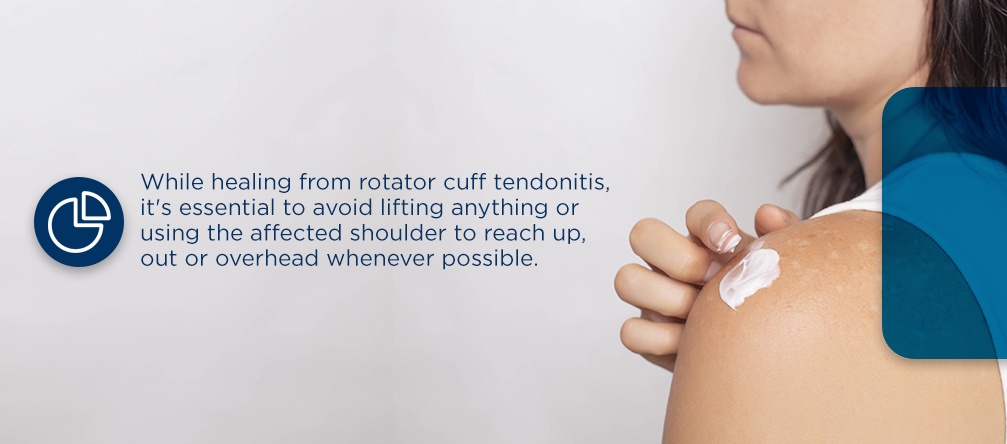
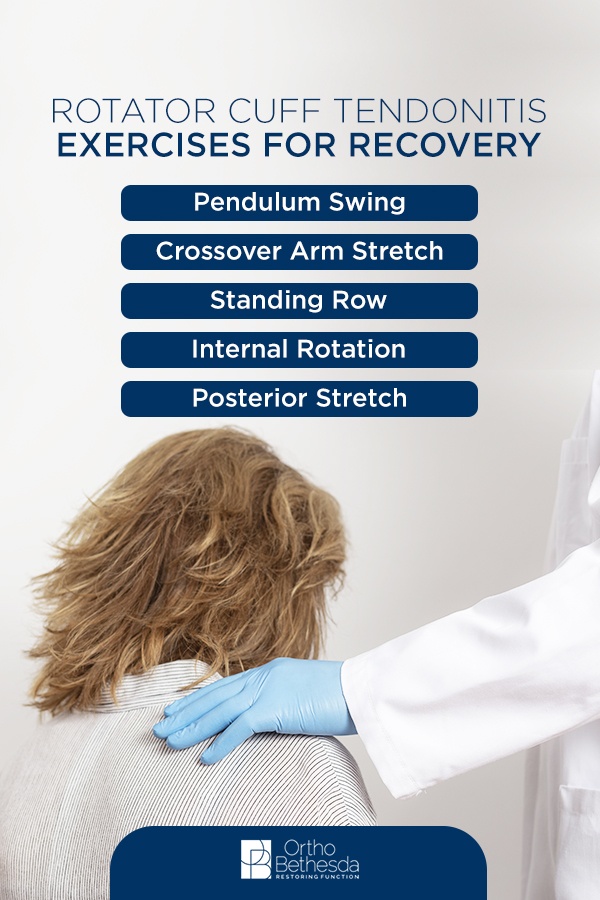
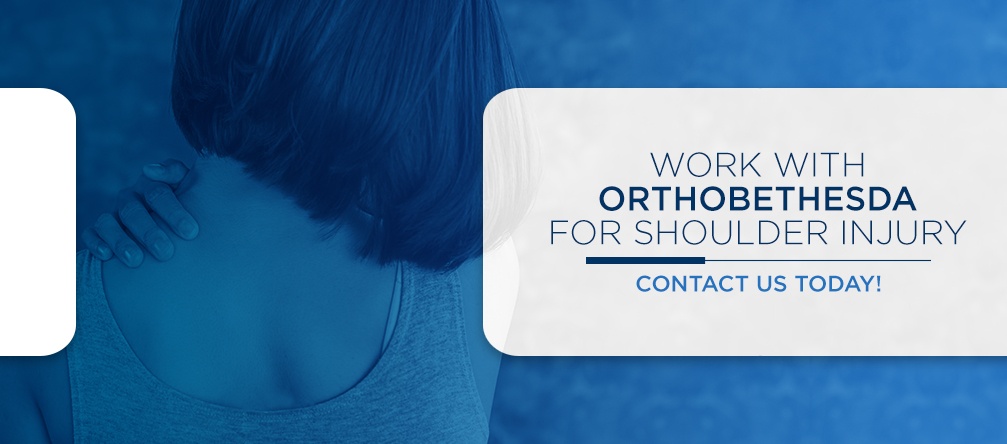
0 Response to "what to expect when rotator cuff tear has to be attached to another tendon"
Post a Comment